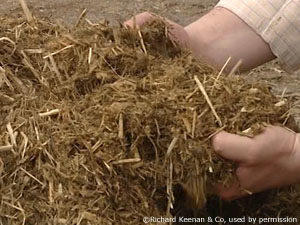Acidic Silage
26 February 2018This winter there have been a high number of acidic silages ie silages with a PAL (Potential Acid Load) value over 900. This figure refers to the potential acid load that occurs in the animals’ rumen when fed this silage. Therefore it relates to both the acid in the silage and the acid produced inside the rumen by the bugs. PAL tends to be higher in wet silages (<20% DM) which have a high digestibility value and a low pH. This is particularly a problem in silages with low fibre levels fed alongside high levels of concentrates. Such silages overload the animals’ ability to maintain the optimum rumen pH of around 6.5 from the alkali in its saliva therefore causing acidosis problems.
Mild acidosis where the animals ability to neutralise acid in its rumen is overcome for just a short period each day will result in animals eating less. Therefore reducing their acid load and allowing their own buffering capacity to cope. However, in a finishing animal this will have a major knock on effect on performance by increasing the length (and cost) of the finishing period up to several weeks!
Long term a low rumen pH gradually “burns off” the rumen villi (the small fingers on the lining of the rumen which increase its surface area to maximise absorption of nutrients into the animals bloodstream.) Should this happen then even if the diet is changed and the rumen pH returns to normal it will still take 1 – 2 months before intakes and performance return to normal. This is due to the time it takes for the animal to regrow the rumen villi.
What To Do?
- Check the PAL value on your silage analysis and the performance of your cattle now.
- If you are concerned speak to your nutritionist now, before any more damage is done.
- Often supplying more straw in the ration, which significantly increases the amount of saliva the cattle produce may be sufficient. However with the shortage and price of straw this year an alternative option could be to use an alkaline feed such as urea treated or sodium hydroxide treated grain. Possibly the simplest approach is to feed sodium bicarbonate by sprinkling it onto the silage as it is being fed, however trials have shown varying results from this method. Normal inclusion rates would be 100-150g/head/day for a 650 kg dry cow or 1-1.5% diet inclusion on a cereal based ration.
- Pay particular attention to the performance of finishing cattle. The inclusion of high levels of cereals to improve performance justadds to the acid load the animal faces, even though it will be eating less silage.
NB Similarly problems will occur in pregnant ewes fed high PAL silages.
Mary McDowell, mary.mcdowell@sac.co.uk
Sign up to the FAS newsletter
Receive updates on news, events and publications from Scotland’s Farm Advisory Service

